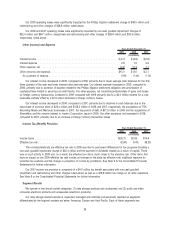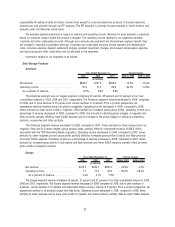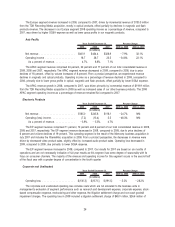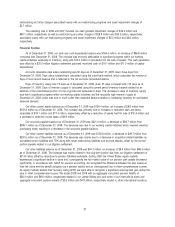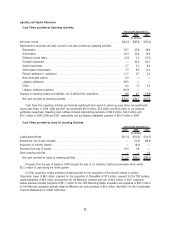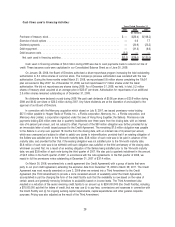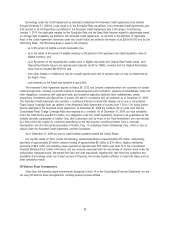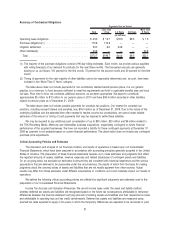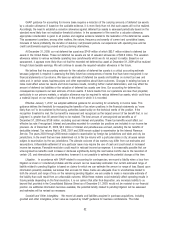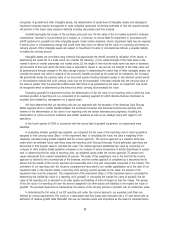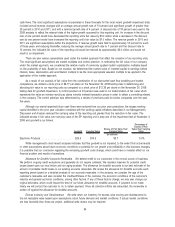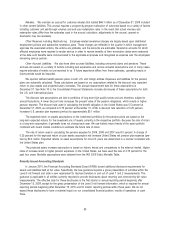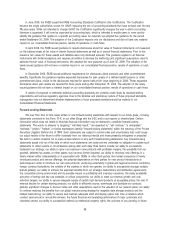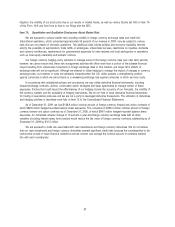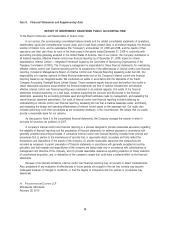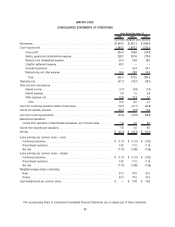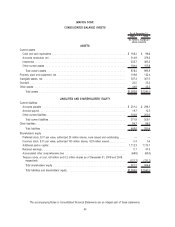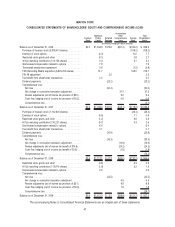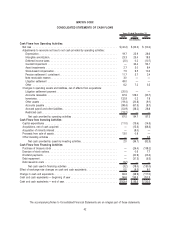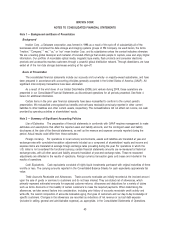Memorex 2009 Annual Report Download - page 41
Download and view the complete annual report
Please find page 41 of the 2009 Memorex annual report below. You can navigate through the pages in the report by either clicking on the pages listed below, or by using the keyword search tool below to find specific information within the annual report.
cash flows. The most significant assumptions incorporated in these forecasts for the most recent goodwill impairment tests
included annual revenue changes with an average annual growth rate of 13 percent and significant growth of greater than
25 percent in 2010 and 2011, and with a terminal growth rate of 4 percent. A discount rate of 18 percent was used in the
2009 analysis to reflect the relevant risks of the higher growth assumed for this reporting unit. An increase in the discount
rate of one percent would have decreased the reporting unit’s fair value by $5.0 million while a decrease in the discount
rate by one percent would have increased the reporting unit’s fair value by $7.0 million. The revenue growth in 2010 and
2011 are significant assumptions within the projections. If revenue growth were held to approximately 10 percent for each
of those years and reducing thereafter, reducing the average annual growth rate to 7 percent and the discount rate to
15 percent, the indicated fair value of the reporting unit would be reduced by approximately $3.0 million and would not
result in an impairment.
There are also various assumptions used under the market approach that affect the valuation of our reporting units.
The most significant assumptions are market multiples and control premium. In estimating the fair value of our company
under the market approach, we considered the relative merits of commonly applied market capitalization multiples based
on the availability of data. Based on our analysis, we determined the market value of invested capital to earnings before
interest, taxes, depreciation and amortization multiple to be the most appropriate valuation multiple to be applied in the
application of the market approach.
As a result of our analysis of fair value from the combination of our discounted cash flow modeling and market
comparisons, we utilized a stock price of $8.77 per share on the November 30, 2009 testing date in determining and
allocating fair value to our reporting units as compared to a stock price of $12.36 per share on the November 30, 2008
testing date for goodwill impairment. A control premium of 25 percent was used in our determination of fair value which
represents the value an investor would pay above minority interest transaction prices in order to obtain a controlling interest
in the company. The control premium was determined by a review of premiums paid for similar companies over the past
five years.
Although our overall expected future cash flows were reduced from our prior year projections, the excess working
capital identified in the prior year valuation combined with the working capital initiatives described in our Management’s
Discussion and Analysis reduced the carrying value of the reporting unit greater than the reduction in fair value. The
indicated excess in fair value over carrying value of the EP reporting unit in step one of the impairment test at November 3,
2009 and goodwill is as follows:
Goodwill Carrying Value
Excess of Fair Value Over
Carrying Value
Percentage of
Excess of Fair
Value Over Carrying
Value
(In millions)
Electronic Products. . . . . . . . . . . . . . . . . . . . . $23.5 $74.3 $3.7 5.0%
While management’s most recent analyses indicates that this goodwill is not impaired, to the extent that actual results
or other assumptions about future economic conditions or potential for our growth and profitability in this business changes,
it is possible that our conclusion regarding the remaining goodwill could change, which could have a material effect on our
financial position and results of operations.
Allowance for Doubtful Accounts Receivable. We extend credit to our customers in the normal course of business.
We perform ongoing credit evaluations and generally do not require collateral. We maintain reserves for potential credit
losses based upon our loss history and our aging analysis. The allowance for doubtful accounts is our best estimate of the
amount of probable credit losses in our existing accounts receivable. We review the allowance for doubtful accounts each
reporting period based on a detailed analysis of our accounts receivable. In the analysis, we consider the age of the
customer’s receivable and also consider the creditworthiness of the customer, the economic conditions of the customer’s
industry and general economic conditions, among other factors. If any of these factors change, we may also change our
original estimates, which could impact the level of our future allowance for doubtful accounts. If payment is not made
timely, we will contact the customer to try to obtain payment. Once all collection efforts are exhausted, the receivable is
written off against the allowance for doubtful accounts.
Excess Inventory and Obsolescence. We write down our inventory for excess, slow moving and obsolescence to
the net realizable value based upon assumptions about future demand and market conditions. If actual market conditions
are less favorable than those we project, additional write downs may be required.
34


